Analysis of Ecosystem Pattern Evolution and Driving Forces in the Qin River Basin in the Middle Reaches of the Yellow River
Abstract
1. Introduction
2. Materials and Methods
2.1. Study Area
2.2. Data Sources and Processing
2.3. Research Methodology
2.3.1. Magnitude of Ecosystem Change
2.3.2. Rate of Ecosystem Change
2.3.3. Dynamics of Ecosystem Types
2.3.4. Field Validation of Remote Sensing Interpretation
- (1)
- Selection of sample points and sample plots
- (2)
- Contents of field surveys
- (3)
- Data processing and validation methods
3. Results
3.1. Distributional Characteristics of Ecosystem Patterns
3.1.1. Spatial Distribution Characteristics
3.1.2. Ecosystem Components
3.2. Characterizing Changes in Ecosystem Patterns
3.2.1. Characterization of Spatial Changes
3.2.2. Changes in Ecosystem Composition
3.3. Analysis of Drivers of Change in the Ecosystem Landscape
3.3.1. Agricultural Development
3.3.2. Ecological Conservation and Restoration
3.3.3. Urbanization
4. Discussion
4.1. Characterization of Changes in Ecosystem Patterns
4.2. Driver Analysis
5. Conclusions
Author Contributions
Funding
Institutional Review Board Statement
Informed Consent Statement
Data Availability Statement
Acknowledgments
Conflicts of Interest
References
- Cantonati, M.; Stevens, L.E.; Segadelli, S.; Springer, A.E.; Goldscheider, N.; Celico, F.; Filippini, M.; Ogata, K.; Gargini, A. Ecohydrogeology: The interdisciplinary convergence needed to improve the study and stewardship of springs and other groundwater-dependent habitats, biota, and ecosystems. Ecol. Indic. 2020, 110, 105803. [Google Scholar] [CrossRef]
- Johnson, K.G.; Budd, A.F.; Stemann, T.A. Extinction selectivity and ecology of Neogene Caribbean reef corals. Paleobiology 2016, 21, 52–73. [Google Scholar] [CrossRef]
- Luyi, M.; Xiaokang, L.; Arnaud, B.; Dieter, K.; Xu, D.; Haijun, S. Morphological complexity promotes origination and extinction rates in ammonoids. Curr. Biol. 2024, 34, 5587–5594.e2. [Google Scholar] [CrossRef]
- Pearce, E.A.; Mazier, F.; Fyfe, R.; Davison, C.W.; Normand, S.; Serge, M.-A.; Scussolini, P.; Svenning, J.-C. Higher abundance of disturbance-favoured trees and shrubs in European temperate woodlands prior to the late-quaternary extinction of megafauna. J. Ecol. 2024, 112, 2813–2827. [Google Scholar] [CrossRef]
- Hrysiewicz, A.; Williamson, J.; Evans, C.D.; Jovani-Sancho, A.J.; Callaghan, N.; Lyons, J.; White, J.; Kowalska, J.; Menichino, N.; Holohan, E.P. Estimation and validation of InSAR-derived surface displacements at temperate raised peatlands. Remote Sens. Environ. 2024, 311, 114232. [Google Scholar] [CrossRef]
- Petty, J.T.; Fulton, J.B.; Strager, M.P.; Merovich, G.T., Jr.; Stiles, J.M.; Ziemkiewicz, P.F. Landscape indicators and thresholds of stream ecological impairment in an intensively mined Appalachian watershed. J. N. Am. Benthol. Soc. 2010, 29, 1292–1309. [Google Scholar] [CrossRef]
- Cianciolo, T.R.; McLaughlin, D.L.; Zipper, C.E.; Timpano, A.J.; Soucek, D.J.; Schoenholtz, S.H. Impacts to water quality and biota persist in mining-influenced Appalachian streams. Sci. Total Environ. 2020, 717, 137216. [Google Scholar] [CrossRef]
- Leitner, P.; Borgwardt, F.; Birk, S.; Graf, W. Multiple stressor effects on benthic macroinvertebrates in very large European rivers—A typology-based evaluation of faunal responses as a basis for future bioassessment. Sci. Total Environ. 2021, 756, 143472. [Google Scholar] [CrossRef]
- Costas, N.; Pardo, I.; Mendez-Fernandez, L.; Martinez-Madrid, M.; Rodriguez, P. Sensitivity of macroinvertebrate indicator taxa to metal gradients in mining areas in Northern Spain. Ecol. Indic. 2018, 93, 207–218. [Google Scholar] [CrossRef]
- Dias, H.Q.; Sukumaran, S.; Neetu, S.; Ridha, H. Benthic community resilience in two differently impacted tropical estuaries: Taxonomic vs functional approaches. J. Environ. Manag. 2022, 324, 116264. [Google Scholar] [CrossRef]
- Korolev, V.A.; Buslaeva, O.V. A system of proper environmental geology categories. Mosc. Univ. Geol. Bull. 2012, 67, 298–307. [Google Scholar] [CrossRef]
- Trofimov, V.T. Ecological geology, environmental geology, geoecology: Contents and relations. Mosc. Univ. Geol. Bull. 2008, 63, 59–69. [Google Scholar] [CrossRef]
- Trofimov, V.T.; Balykova, S.D.; Nikolaeva, S.K. Engineering and Ecological Geology at Moscow State University in the 2008–2017 Period (to the 80th Anniversary of the Chair of Engineering and Ecological Geology). Mosc. Univ. Geol. Bull. 2018, 73, 1–12. [Google Scholar] [CrossRef]
- Peng, J.; Shen, Z.; Zhang, W.; Song, W. Deep-Learning-Enhanced CT Image Analysis for Predicting Hydraulic Conductivity of Coarse-Grained Soils. Water 2023, 15, 2623. [Google Scholar] [CrossRef]
- Marquez, C.O.; Garcia, V.J.; Schultz, R.C.; Isenhart, T.M. A conceptual framework to study soil aggregate dynamics. Eur. J. Soil Sci. 2019, 70, 466–479. [Google Scholar] [CrossRef]
- Zhang, C.; Liu, Z.; Deng, P. Contact angle of soil minerals: A molecular dynamics study. Comput. Geotech. 2016, 75, 48–56. [Google Scholar] [CrossRef]
- Zhang, Z.; Furman, A. Soil redox dynamics under dynamic hydrologic regimes—A review. Sci. Total Environ. 2021, 763, 143026. [Google Scholar] [CrossRef]
- Guo, X.-Y.; Li, J.; Jia, Y.-H.; Yuan, G.-L.; Zheng, J.-L.; Liu, Z.-J. Geochemistry Process from Weathering Rocks to Soils: Perspective of an Ecological Geology Survey in China. Sustainability 2023, 15, 1002. [Google Scholar] [CrossRef]
- Callow, J.N.; Hipsey, M.R.; Vogwill, R.I.J. Surface water as a cause of land degradation from dryland salinity. Hydrol. Earth Syst. Sci. 2020, 24, 717–734. [Google Scholar] [CrossRef]
- Smith, J.D.; Koenig, L.E.; Sleckman, M.J.; Appling, A.P.; Sadler, J.M.; DePaul, V.T.; Szabo, Z. Predictive Understanding of Stream Salinization in a Developed Watershed Using Machine Learning. Environ. Sci. Technol. 2024, 58, 18822–18833. [Google Scholar] [CrossRef]
- Zhang, S.; Xiong, K.; Min, X.; Zhu, D. Vegetation vulnerability in karst desertification areas is related to land-atmosphere feedback induced by lithology. Catena 2024, 247, 108542. [Google Scholar] [CrossRef]
- Wang, Q.; Xiong, K.; Zhou, J.; Xiao, H.; Song, S. Impact of land use and land cover change on the landscape pattern and service value of the village ecosystem in the karst desertification control. Front. Environ. Sci. 2023, 11, 1020331. [Google Scholar] [CrossRef]
- D’Ettorre, U.S.; Liso, I.S.; Parise, M. Desertification in karst areas: A review. Earth-Sci. Rev. 2024, 253, 104786. [Google Scholar] [CrossRef]
- Korolev, V.A.; Trofimov, V.T. The Development of a General Classification of Continental Ecological-Geological Systems. Mosc. Univ. Geol. Bull. 2022, 77, 211–219. [Google Scholar] [CrossRef]
- Chen, Q.; Ning, Y. Projecting LUCC dynamics and ecosystem services in an emerging urban agglomeration under SSP-RCP scenarios and their management implications. Sci. Total Environ. 2024, 949, 175100. [Google Scholar] [CrossRef] [PubMed]
- Giovannelli, D.; Barry, P.H.; de Moor, J.M.; Jessen, G.L.; Schrenk, M.O.; Lloyd, K.G. Sampling across large-scale geological gradients to study geosphere-biosphere interactions. Front. Microbiol. 2022, 13, 998133. [Google Scholar] [CrossRef]
- Zoelch, T.; Wamsler, C.; Pauleit, S. Integrating the ecosystem-based approach into municipal climate adaptation strategies: The case of Germany. J. Clean. Prod. 2018, 170, 966–977. [Google Scholar] [CrossRef]
- Plakidas, K.; Schall, D.; Zdun, U. Evolution of the R software ecosystem: Metrics, relationships, and their impact on qualities. J. Syst. Softw. 2017, 132, 119–146. [Google Scholar] [CrossRef]
- Wang, J.; He, T.; Lin, Y. Changes in ecological, agricultural, and urban land space in 1984-2012 in China: Land policies and regional social-economical drivers. Habitat Int. 2018, 71, 1–13. [Google Scholar] [CrossRef]
- Cheng, M.; Huang, B.; Kong, L.; Ouyang, Z. Ecosystem Spatial Changes and Driving Forces in the Bohai Coastal Zone. Int. J. Environ. Res. Public Health 2019, 16, 536. [Google Scholar] [CrossRef]
- Liao, Z.; Su, K.; Jiang, X.; Zhou, X.; Yu, Z.; Chen, Z.; Wei, C.; Zhang, Y.; Wang, L. Ecosystem and Driving Force Evaluation of Northeast Forest Belt. Land 2022, 11, 1306. [Google Scholar] [CrossRef]
- Ma, G.; Li, Q.; Yang, S.; Zhang, R.; Zhang, L.; Xiao, J.; Sun, G. Analysis of Landscape Pattern Evolution and Driving Forces Based on Land-Use Changes: A Case Study of Yilong Lake Watershed on Yunnan-Guizhou Plateau. Land 2022, 11, 1276. [Google Scholar] [CrossRef]
- Gao, Z.-Q.; Bai, Y.-P.; Zhou, L.; Qiao, F.-W.; Song, L.-J.; Chen, X.-N. Characteristics and driving forces of wetland landscape pattern evolution of the city belt along the Yellow River in Ningxia, China. Ying Yong Sheng Tai Xue Bao J. Appl. Ecol. 2020, 31, 3499–3508. [Google Scholar] [CrossRef]
- Guarderas, P.; Smith, F.; Dufrene, M. Land use and land cover change in a tropical mountain landscape of northern Ecuador: Altitudinal patterns and driving forces. PLoS ONE 2022, 17, e0260191. [Google Scholar] [CrossRef]
- Peng, J.; Zhao, M.; Guo, X.; Pan, Y.; Liu, Y. Spatial-temporal dynamics and associated driving forces of urban ecological land: A case study in Shenzhen City, China. Habitat Int. 2017, 60, 81–90. [Google Scholar] [CrossRef]
- Sun, M.-H.; Niu, W.-H.; Zhang, B.-B.; Geng, Q.-L.; Yu, Q. Spatial-temporal evolution and responses of ecosystem service value under land use change in the Yellow River Basin: A case study of Shaanxi-Gansu-Ningxia region, Northwest China. Ying Yong Sheng Tai Xue Bao J. Appl. Ecol. 2021, 32, 3913–3922. [Google Scholar] [CrossRef]
- Su, K.; Liu, H.; Wang, H. Spatial-Temporal Changes and Driving Force Analysis of Ecosystems in the Loess Plateau Ecological Screen. Forests 2022, 13, 54. [Google Scholar] [CrossRef]
- Yang, L.; Liu, F. Spatio-Temporal Evolution and Driving Factors of Ecosystem Service Value of Urban Agglomeration in Central Yunnan. Sustainability 2022, 14, 10823. [Google Scholar] [CrossRef]
- Pan, Z.; Gao, G.; Fu, B. Spatiotemporal changes and driving forces of ecosystem vulnerability in the Yangtze River Basin, China: Quantification using habitat-structure-function framework. Sci. Total Environ. 2022, 835, 155494. [Google Scholar] [CrossRef]
- Zhou, L.; Wang, L.; Su, K.; Bi, G.; Chen, H.; Liu, X.; Yang, Q. Spatiotemporal Characteristics of Rural Restructuring Evolution and Driving Forces in Mountainous and Hilly Areas. Land 2022, 11, 848. [Google Scholar] [CrossRef]
- Shao, M.; Wu, L.; Li, F.; Lin, C. Spatiotemporal Dynamics of Ecosystem Services and the Driving Factors in Urban Agglomerations: Evidence From 12 National Urban Agglomerations in China. Front. Ecol. Evol. 2022, 10, 804969. [Google Scholar] [CrossRef]
- Zhang, M.; Du, H.; Zhou, G.; Mao, F.; Li, X.; Zhou, L.; Zhu, D.; Xu, Y.; Huang, Z. Spatiotemporal Patterns and Driving Force of Urbanization and Its Impact on Urban Ecology. Remote Sens. 2022, 14, 1160. [Google Scholar] [CrossRef]
- Yang, L.; Sun, Z.; Li, J.; Shi, L.; Kong, H.; Yang, Y.; Li, T. Spatiotemporal patterns and driving forces of land-use and land-cover change in the Mu Us Sandy Land, China from 1980 to 2018. Arid. Land Res. Manag. 2022, 36, 109–124. [Google Scholar] [CrossRef]
- He, C.; Shao, H.; Xian, W. Spatiotemporal Variation and Driving Forces Analysis of Eco-System Service Values: A Case Study of Sichuan Province, China. Int. J. Environ. Res. Public Health 2022, 19, 8595. [Google Scholar] [CrossRef]
- Wang, Z.; Zhao, H.; Zhao, C. Temporal and Spatial Evolution Characteristics of Land Use and Landscape Pattern in Key Wetland Areas of the West Liao River Basin, Northeast China. J. Environ. Eng. Landsc. Manag. 2022, 30, 195–205. [Google Scholar] [CrossRef]
- Zhang, X.; Li, H.; Xia, H.; Tian, G.; Yin, Y.; Lei, Y.; Kim, G. The Ecosystem Services Value Change and Its Driving Forces Responding to Spatio-Temporal Process of Landscape Pattern in the Co-Urbanized Area. Land 2021, 10, 1043. [Google Scholar] [CrossRef]
- Li, Z.; Liu, M.; Hu, Y.; Xue, Z.; Sui, J. The spatiotemporal changes of marshland and the driving forces in the Sanjiang Plain, Northeast China from 1980 to 2016. Ecol. Process. 2020, 9, 24. [Google Scholar] [CrossRef]
- Chang, S.; Wei, Y.; Dai, Z.; Xu, W.; Wang, X.; Duan, J.; Zou, L.; Zhao, G.; Ren, X.; Feng, Y. Landscape ecological risk assessment and its driving factors in the Weihe River basin, China. J. Arid Land 2024, 16, 603–614. [Google Scholar] [CrossRef]
- Tang, Z.; Zhou, Z.; Wang, D.; Luo, F.; Bai, J.; Fu, Y. Impact of vegetation restoration on ecosystem services in the Loess plateau, a case study in the Jinghe Watershed, China. Ecol. Indic. 2022, 142, 109183. [Google Scholar] [CrossRef]
- Du, H.; Wu, J.; Li, W.; Wan, Y.; Yang, M.; Feng, P. Temporal-Spatial Characteristics and Trade-off-Synergy Relationships of Water-Related Ecosystem Services in the Yangtze River Basin from 2001 to 2021. Sustainability 2024, 16, 3605. [Google Scholar] [CrossRef]


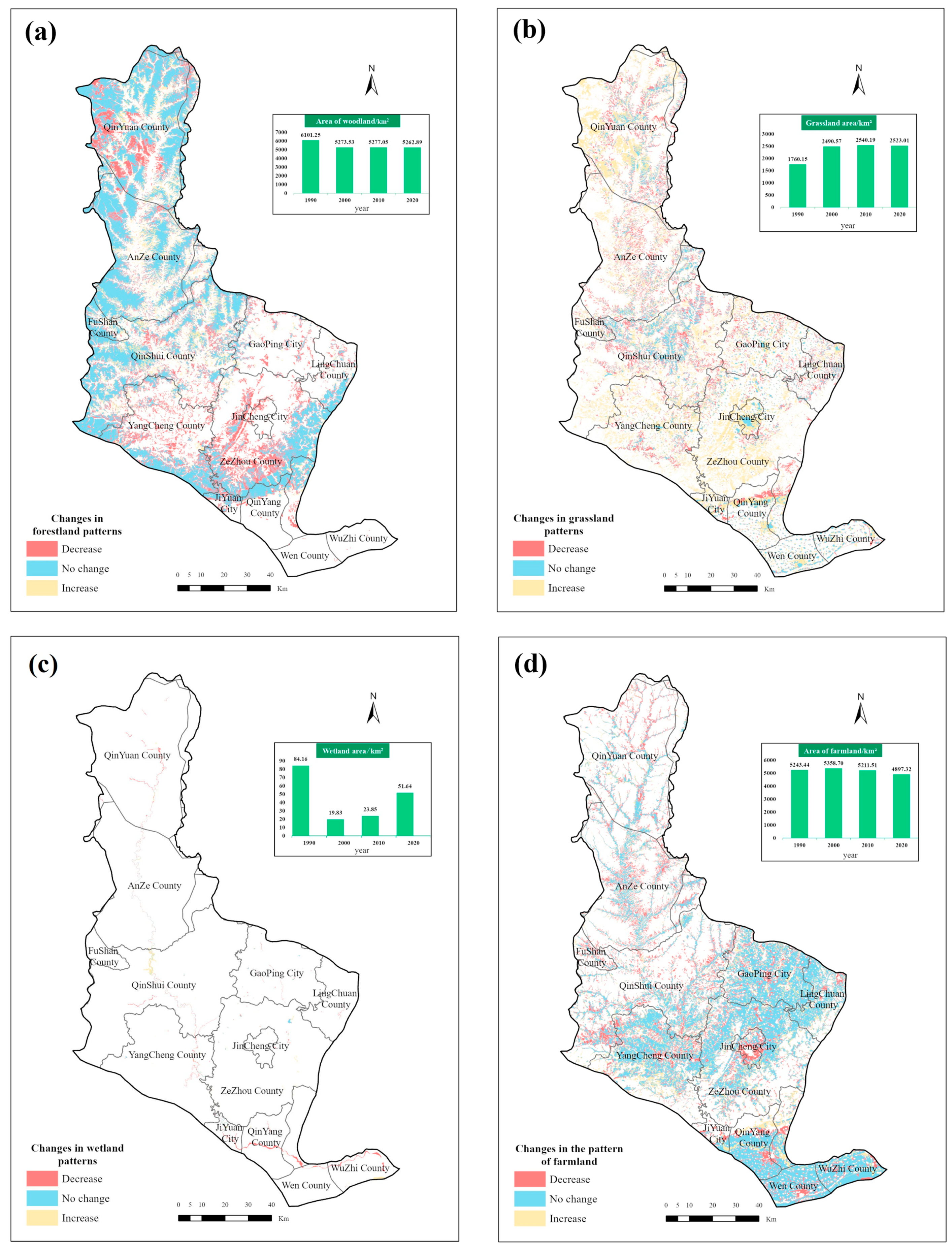
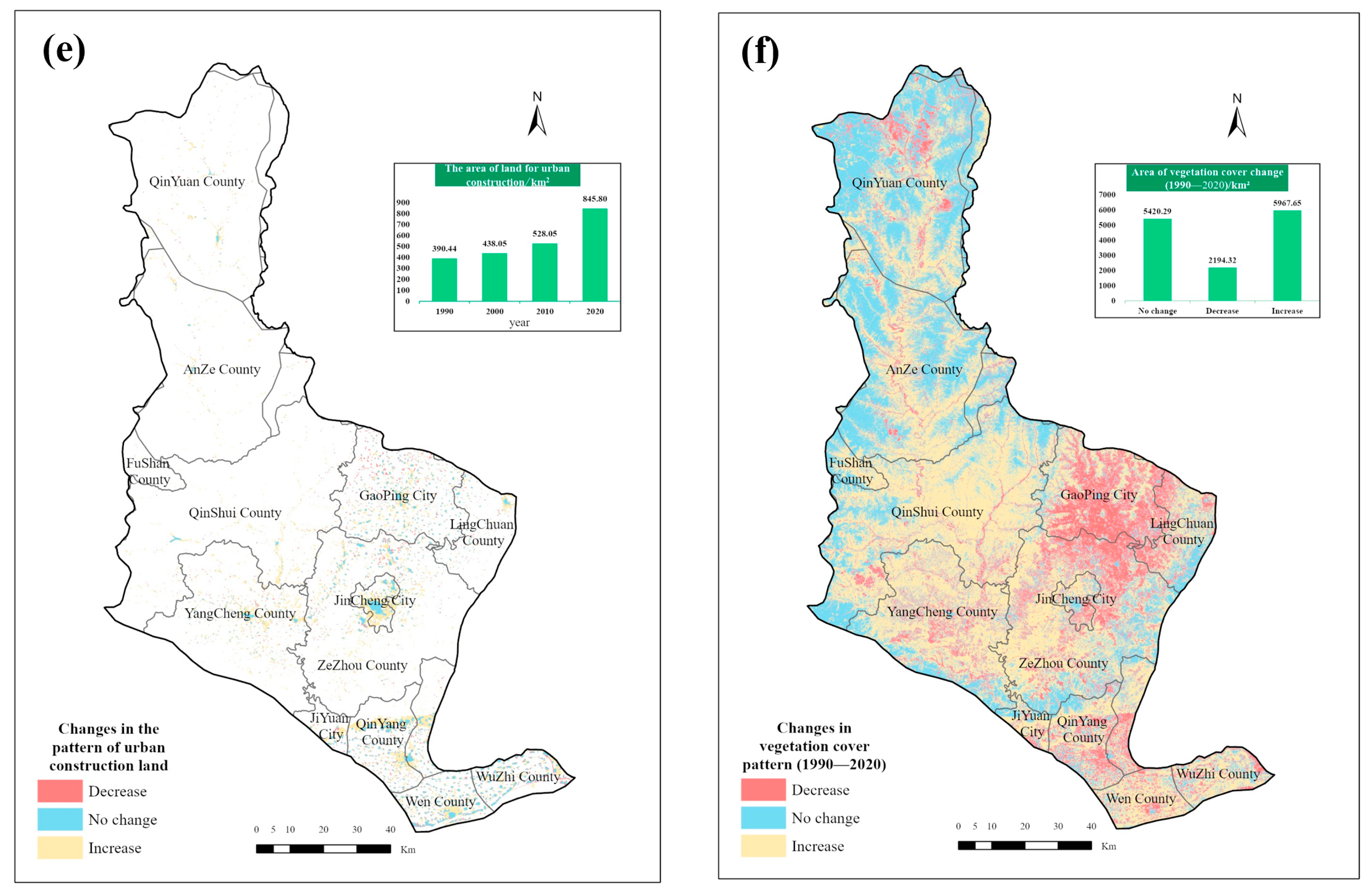
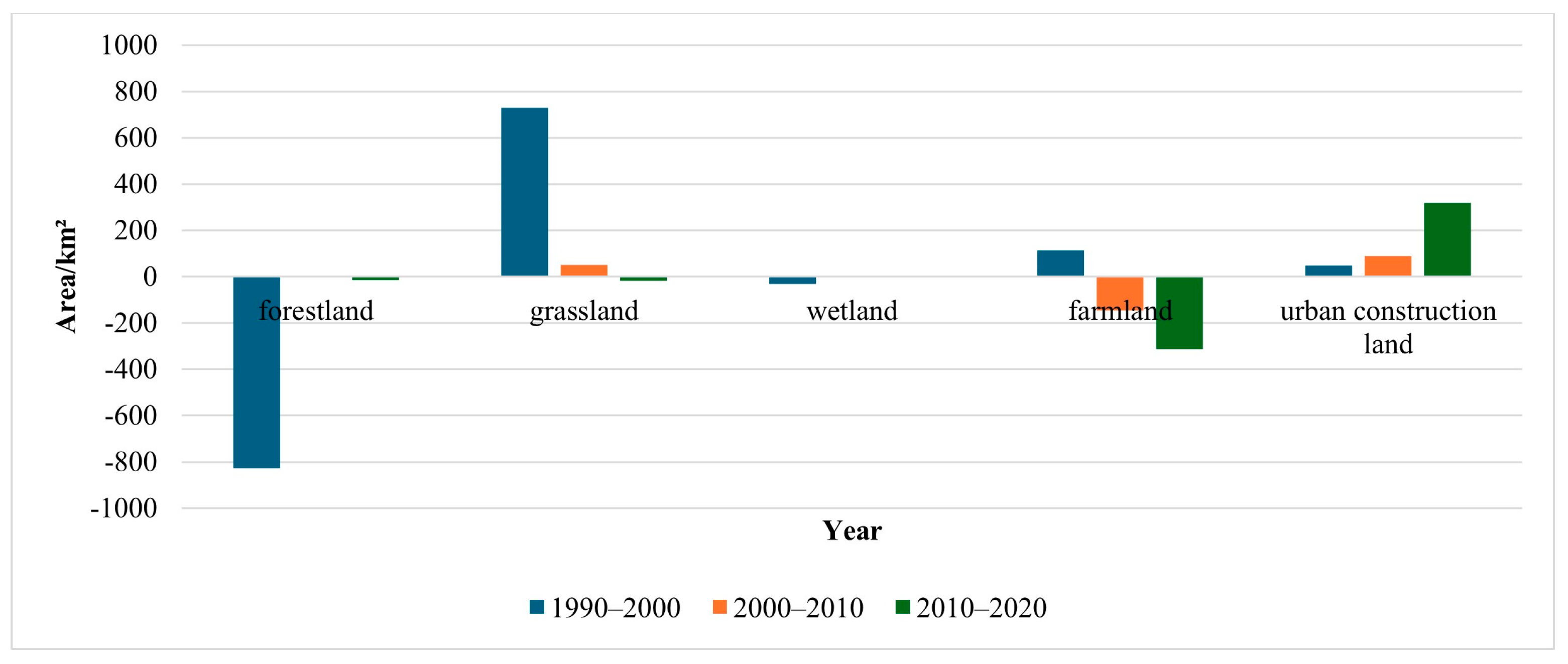
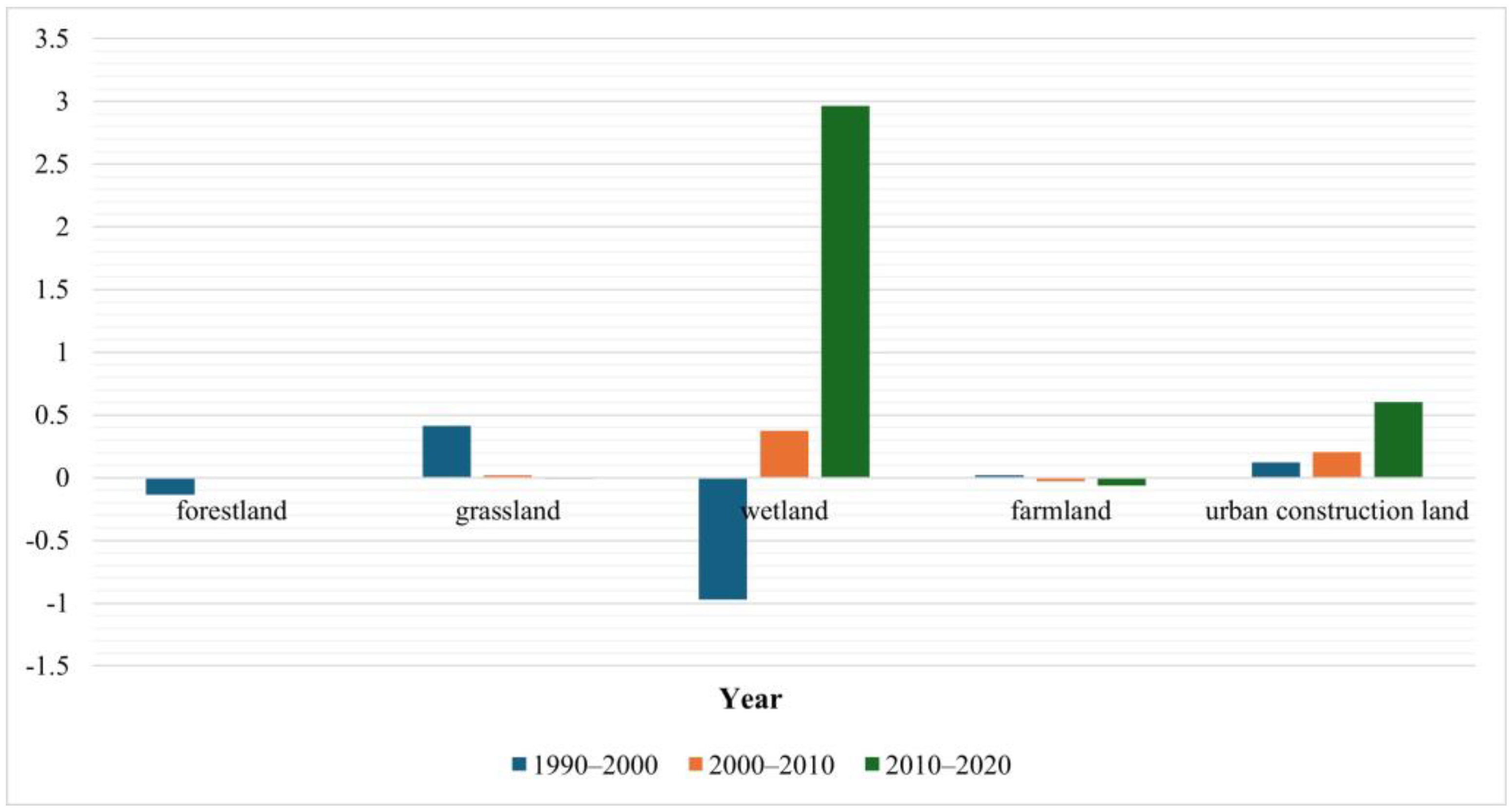
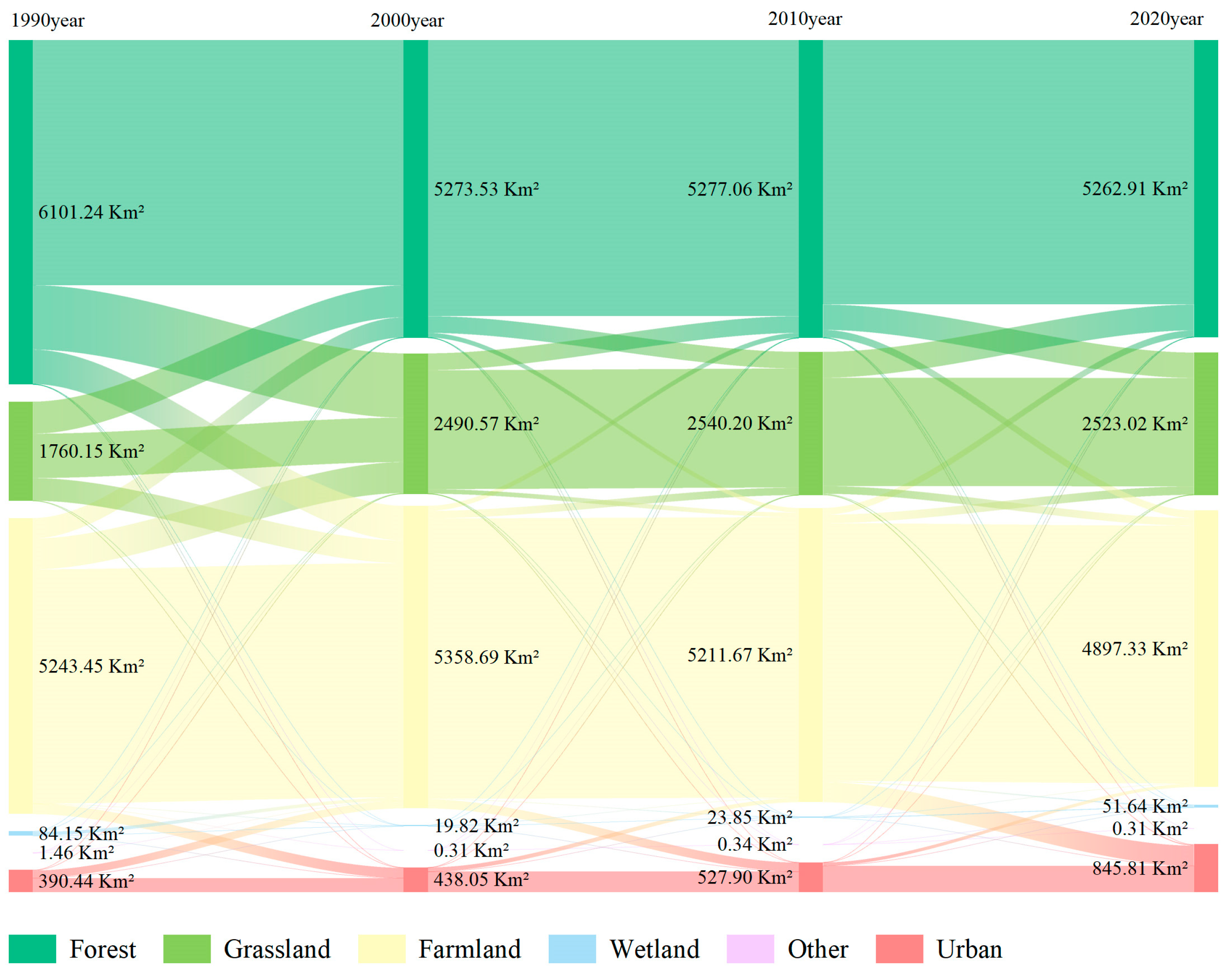
| No. | Data Type | Data Source | Data Precision |
|---|---|---|---|
| 1 | Forest | Data Center for Resources and Environmental Sciences, Chinese Academy of Sciences Remote sensing monitoring data of land use/land cover in China over multiple periods | 83.21% |
| 2 | Grassland | 88.33% | |
| 3 | Wetland | 92.28% | |
| 4 | Farmland | 89.04% | |
| 5 | Urban | 97.44% | |
| 6 | Other | 91.37% |
| Ecosystem Types | 1990 | 2000 | 2010 | 2020 | ||||
|---|---|---|---|---|---|---|---|---|
| Area (km2) | Proportion | Area (km2) | Proportion | Area (km2) | Proportion | Area (km2) | Proportion | |
| FL 1 | 5243.44 | 38.61% | 5358.70 | 39.46% | 5211.51 | 38.37% | 4897.32 | 36.06% |
| FE 2 | 6101.25 | 44.93% | 5273.53 | 38.83% | 5277.05 | 38.86% | 5262.89 | 38.75% |
| GE 3 | 1760.15 | 12.96% | 2490.57 | 18.34% | 2540.19 | 18.70% | 2523.01 | 18.58% |
| UE 4 | 390.44 | 2.87% | 438.05 | 3.23% | 528.05 | 3.89% | 845.80 | 6.23% |
| WE 5 | 84.16 | 0.62% | 19.83 | 0.15% | 23.85 | 0.18% | 51.64 | 0.38% |
| OE 6 | 1.46 | 0.01% | 0.31 | 0.00% | 0.33 | 0.00% | 0.31 | 0.00% |
| Time | Typology | Grassland | Farmland | Bare Ground | Forest | Wetland | Home | Total |
|---|---|---|---|---|---|---|---|---|
| 1990–2000 | Grassland | 786.43 | 548.58 | 0.03 | 1140.47 | 10.27 | 4.78 | 2490.55 |
| Farmland | 400.80 | 4150.48 | 1.33 | 611.46 | 59.04 | 135.54 | 5358.65 | |
| Bare ground | 0.00 | 0.02 | 0.00 | 0.29 | 0.00 | 0.00 | 0.31 | |
| Forest | 567.73 | 358.37 | 0.10 | 4341.02 | 4.19 | 2.11 | 5273.51 | |
| Wetland | 1.13 | 5.43 | 0.00 | 3.51 | 9.42 | 0.33 | 19.83 | |
| Home | 4.06 | 180.57 | 0.00 | 4.49 | 1.23 | 247.68 | 438.04 | |
| Total | 1760.15 | 5243.44 | 1.46 | 6101.24 | 84.16 | 390.44 | 13,580.98 | |
| 2000–2010 | Grassland | 2107.13 | 133.09 | 0.01 | 297.08 | 2.11 | 0.77 | 2540.19 |
| Farmland | 81.19 | 4965.59 | 0.00 | 83.51 | 7.31 | 74.04 | 5211.65 | |
| Bare ground | 0.02 | 0.00 | 0.12 | 0.19 | 0.00 | 0.00 | 0.33 | |
| Forest | 297.97 | 89.07 | 0.17 | 4888.75 | 0.86 | 0.23 | 5277.05 | |
| Wetland | 2.04 | 11.03 | 0.00 | 1.38 | 9.29 | 0.11 | 23.85 | |
| Home | 2.22 | 159.91 | 0.00 | 2.62 | 0.25 | 362.90 | 527.90 | |
| Total | 2490.57 | 5358.69 | 0.31 | 5273.53 | 19.83 | 438.04 | 13,580.98 | |
| 2010–2020 | Grassland | 1919.18 | 150.47 | 0.02 | 450.53 | 1.39 | 1.43 | 2523.01 |
| Farmland | 136.52 | 4563.72 | 0.00 | 133.51 | 5.49 | 58.09 | 4897.32 | |
| Bare ground | 0.00 | 0.00 | 0.03 | 0.28 | 0.00 | 0.00 | 0.31 | |
| Forest | 458.99 | 120.94 | 0.28 | 4682.10 | 0.31 | 0.29 | 5262.89 | |
| Wetland | 8.38 | 21.19 | 0.01 | 5.33 | 16.32 | 0.41 | 51.64 | |
| Home | 17.13 | 355.35 | 0.00 | 5.31 | 0.34 | 467.68 | 845.80 | |
| Total | 2540.19 | 5211.65 | 0.33 | 5277.05 | 23.85 | 527.90 | 13,580.98 |
| Projects | Urbanization | Agricultural Development | Ecological Protection and Restoration | |
|---|---|---|---|---|
| Changes in ecosystem area | Grassland | 23.41 | 618.51 | / |
| Farmland | 695.83 | / | 1071.30 | |
| Bare ground | 0.00 | 1.33 | 0.00 | |
| Forest | 12.42 | 828.48 | / | |
| Wetland | 1.82 | 84.65 | 0.00 | |
| Home | / | 267.67 | 377.92 | |
| Total | 733.48 | 1787.83 | 1449.22 | |
| Contribution rate | 18.47% | 45.03% | 36.50% | |
Disclaimer/Publisher’s Note: The statements, opinions and data contained in all publications are solely those of the individual author(s) and contributor(s) and not of MDPI and/or the editor(s). MDPI and/or the editor(s) disclaim responsibility for any injury to people or property resulting from any ideas, methods, instructions or products referred to in the content. |
© 2025 by the authors. Licensee MDPI, Basel, Switzerland. This article is an open access article distributed under the terms and conditions of the Creative Commons Attribution (CC BY) license (https://creativecommons.org/licenses/by/4.0/).
Share and Cite
Liu, Y.; Zang, M.; Peng, J.; Bai, Y.; Wang, S.; Wang, Z.; Shi, P.; Liu, M.; Xu, K.; Zhang, N. Analysis of Ecosystem Pattern Evolution and Driving Forces in the Qin River Basin in the Middle Reaches of the Yellow River. Sustainability 2025, 17, 6199. https://doi.org/10.3390/su17136199
Liu Y, Zang M, Peng J, Bai Y, Wang S, Wang Z, Shi P, Liu M, Xu K, Zhang N. Analysis of Ecosystem Pattern Evolution and Driving Forces in the Qin River Basin in the Middle Reaches of the Yellow River. Sustainability. 2025; 17(13):6199. https://doi.org/10.3390/su17136199
Chicago/Turabian StyleLiu, Yi, Mingdong Zang, Jianbing Peng, Yuze Bai, Siyuan Wang, Zibin Wang, Peidong Shi, Miao Liu, Kairan Xu, and Ning Zhang. 2025. "Analysis of Ecosystem Pattern Evolution and Driving Forces in the Qin River Basin in the Middle Reaches of the Yellow River" Sustainability 17, no. 13: 6199. https://doi.org/10.3390/su17136199
APA StyleLiu, Y., Zang, M., Peng, J., Bai, Y., Wang, S., Wang, Z., Shi, P., Liu, M., Xu, K., & Zhang, N. (2025). Analysis of Ecosystem Pattern Evolution and Driving Forces in the Qin River Basin in the Middle Reaches of the Yellow River. Sustainability, 17(13), 6199. https://doi.org/10.3390/su17136199







